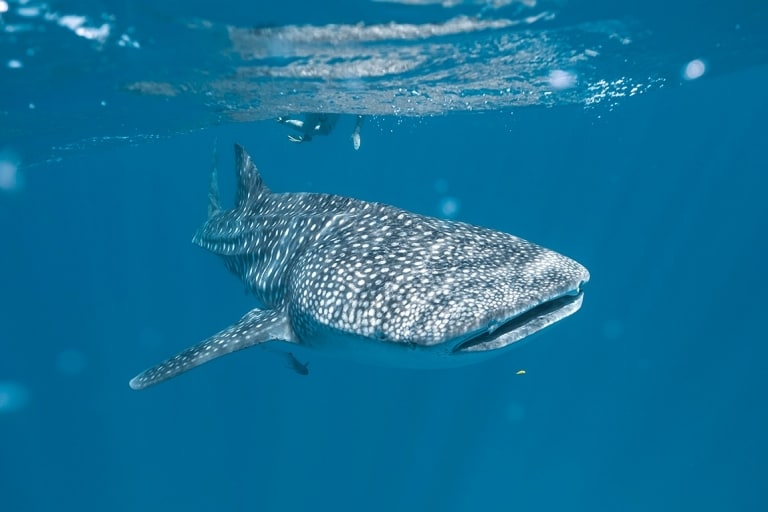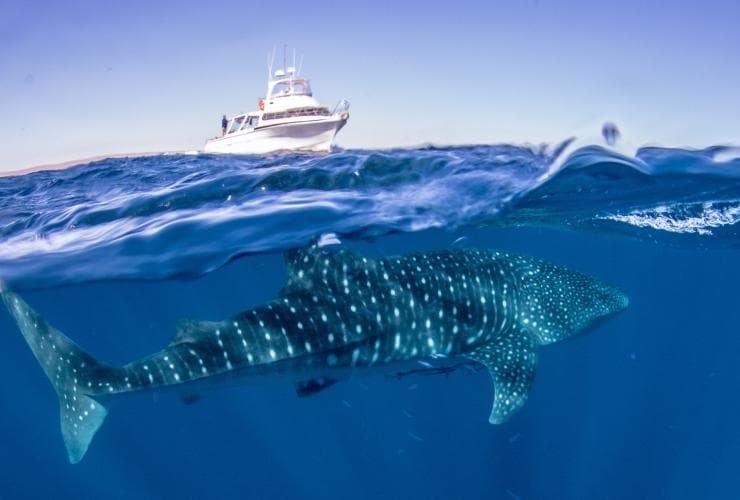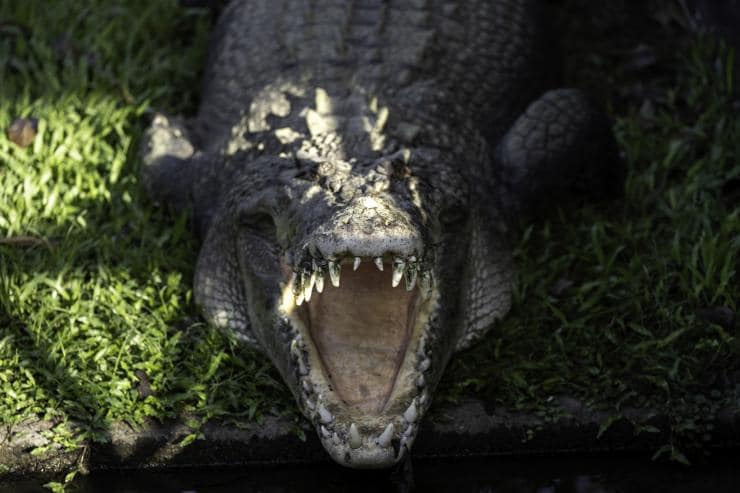
Whale shark, Exmouth, Western Australia © Tourism Australia
8 wildlife events to catch in autumn
Where to see Australia’s most spectacular wildlife happenings in March, April and May.
Many of Australia’s most awe-inspiring wild animal events happen in autumn. As the weather cools in March, April and May, many of the world’s great migrations begin on land, in the sea and in the air. It’s also a great time to see young animals in the wild. Prepare to be blown away by these incredible animal encounters.
Swim with whale sharks

Whale Shark, Ningaloo Marine Park, Western Australia © Exmouth Dive and Whalesharks Ningaloo
When: April, May, and June
Where: Ningaloo Reef, Western Australia
There’s only one way to describe the experience of swimming beside the biggest fish in the sea and that’s “awesome”. Don’t be misled by the name, the whale shark – which can be as big as a school bus and weigh up to 20 tonnes – is actually a fish. They may be giants of the deep, but they’re gentle ones. They come to feast on plankton in the waters of Ningaloo Marine Park (a two-hour flight from Perth) in large numbers from April through to early June.
How: Jump right in and swim with them on a tour from Exmouth or Coral Bay.
Mingle with mantas

Manta Rays, Lady Elliot Island, Queensland © James Vodicka
When: May and June
Where: Lady Elliot Island, Queensland
If you’ve ever wondered what it might be like to fly underwater, diving or snorkelling with manta rays on Lady Elliot Island will give you a bit of a clue. Lady Elliot’s actually a coral cay (rather than an island) at the southern tip of the Great Barrier Reef off Bundaberg, and is a major hotspot for these graceful but harmless creatures that can grow up to seven metres (23 feet), wing tip to wing tip. The mantas are here all year, but gather in large numbers during the cooler months between May and August, which is also when the water is clearest – so you’re guaranteed a good view.
How: Book a snorkel safari to swim with graceful mantas.
Smile at baby crocodiles

Saltwater Crocodile, FNQ Nature Tours, Daintree River, Queensland © FNQ Nature Tours
When: March and April
Where: Cairns and the Great Barrier Reef Region
Forget the children’s song Never Smile at a Crocodile; it's hard not to grin when you spot a baby "saltie". Because let's face it, all baby animals are lovable, even saltwater crocs. Join a wildlife-spotting tour in the north of Queensland from May through to November, and you’re likely to see several of these majestic creatures sunning themselves on the riverbanks. Visit in April and May and you might just be lucky enough to see some crocodile babies, as that's the time of year the tiny crocodiles hatch from their eggs.
How: Venture out on a croc spotting expedition.
Wave farewell to a million muttonbirds

Echidna Walkabout Tours, Great Ocean Road, Victoria © Echidna Walkabout Tours/Visit Victoria
When: April
Where: Southern Victoria
If nature gave out awards for long distance travel, the muttonbird would win first prize. Every year, this amazing bird (also called a short-tailed shearwater), flies an epic 16,000 kilometres (9,940 miles) from Alaska to southern Victoria in less than eight weeks to nest in the sand dunes and lay eggs. Around a million arrive in September, and then leave again in mid-April. Watching the sky darken with a multitude of wings as they take to the skies on Phillip Island and along the Great Ocean Road (both south of Melbourne) at sunset is one of nature’s greatest and certainly unmissable air shows.
How: Spot birds and other wildlife along the Great Ocean Road.
Hang out with baby quokkas

Quokkas, Rottnest Island, Western Australia © Tourism Australia
When: April and May
Where: Rottnest Island, Western Australia
There’s no best time of year to score the perfect quokka photo for your feed because the adorable teddy-bear-sized marsupial nicknamed “the world’s happiest animal” is always happy to pose. Quokkas do like to snooze in the shade in the middle of the day, so late afternoon is best.
The quokka, famous for its cute little smiling face and trusting nature, is native to Rottnest Island, a 25-minute ferry ride from Fremantle, just south of Perth. For an extra dose of sweetness, if you go in April or May you might snap a photo of a quokka with a ‘joey’ (newborn marsupial) peeking out of her pouch.
How: Take the Rottnest Fast Ferry to the island and venture away from the crowds to find quokkas grazing on the brush.
Check out the chicks

Lords Kakadu & Arnhemland Safaris, Fogg Dam, Northern Territory © Lords Kakadu & Arnhemland Safaris
When: April and May
Where: Kakadu National Park, Northern Territory
If you’re a keen ‘twitcher’ (birdwatcher) you’ll know there’s nothing more exciting than spotting a bird on your list for the first time. Seeing the chicks of a bird on your list? Well, that’s even better. April and May is breeding time in Kakadu, a three-hour drive east of Darwin, and prime time to spot the chicks of some of the Top End’s most iconic bird species. Birds to look for in the billabongs and wetlands include the black-necked stork (jabiru), magpie goose, comb-crested jacana and the brilliantly coloured azure kingfisher.
How: Join a Kakadu birding tour for the ultimate birdlife safari.
Cruise with one-tonne baby sperm whales

Sperm Whale, Naturaliste Charters, Augusta, Western Australia © Naturaliste Charters/Keith Lightbody
When: March and April
Where: Southern Western Australia
Did you know that the sperm whale has the largest brain of any creature on Earth? These amazing beasts, which can grow up to 15 metres (49 feet) long and weigh 30 tonnes, like to graze on the giant squid found in the deep canyons along the southern coast of Western Australia. Even the calves are big, weighing in at almost a tonne when they are born. Head to Augusta, a 3.5-hour drive south of Perth, to see these oceanic acrobats put on a display.
How: Join a whale watching tour in March or April for the best chance at seeing sperm whales.
Hear a devil growl in the dark

Tasmanian Devil, Devils@Cradle, Cradle Mountain National Park, Tasmania © Stu Gibson/Tourism Tasmania
When: March, April and May
Where: Tasmania
The creature that everyone wants to see when they visit Tasmania is the eponymous Tasmanian devil – the world’s largest meat-eating marsupial. Found all over the island state, but partial to coastal and scrubland areas, devils tend to hang out on their own until breeding season (March, April and May), when the male has to fight for the female’s attention; including lots of very loud howling and growling. The shrieks can be heard several kilometres (more than a mile) away. It all happens after dark and listening to a devil scream in the middle of the night is a thrilling experience you won’t soon forget.
How: To hear and see devils at night, book a nocturnal tour at Cradle Mountain sanctuary Devils@Cradle.


































































































































